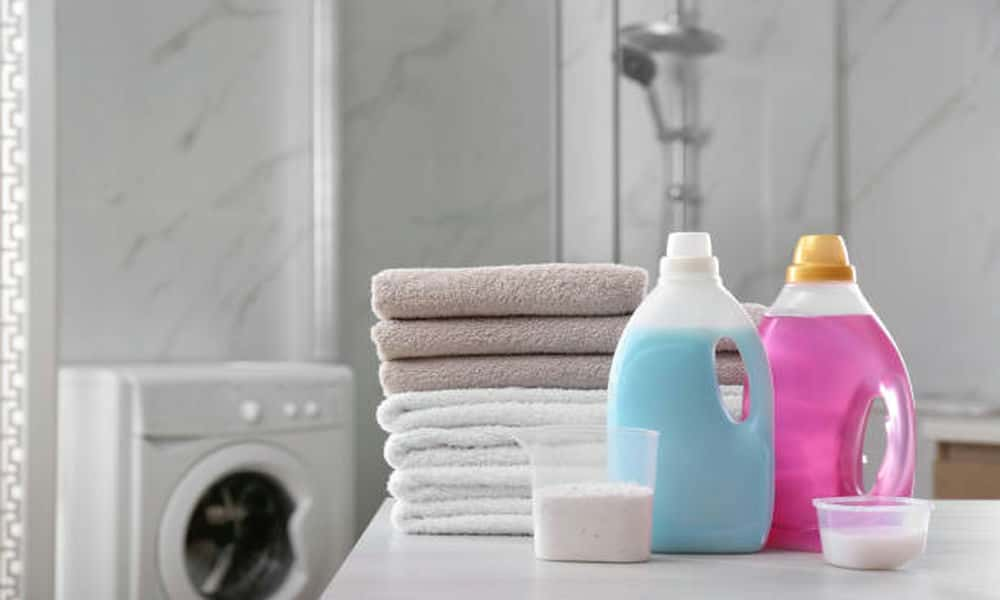Can Fabric Softener Be Used as Detergent? The Ultimate Guide

Can Fabric Softener Be Used as Detergent? If you’ve ever found yourself short on laundry detergent, you might wonder if you can substitute fabric softener. While both products enhance your laundry routine, they have distinct roles.
Fabric softeners primarily focus on softening clothes and reducing static, giving them that comfy feel. Conversely, detergents are designed to lift and remove dirt, stains, and oils from fabrics. While fabric softeners aren’t intended for cleaning, there are a few cases where they can play a helpful role.
In this article, we’ll explore whether fabric softener can truly replace detergent and under what circumstances. Let’s dive in and uncover the secrets behind these laundry room essentials.
What is Detergent?

Detergent is a cleaning agent designed to remove dirt, stains, and odors from fabric. Made primarily of surfactants, detergents break down oils and dirt so that they can be washed away with water.
Types of Detergents
- Liquid: Good for pre-treating stains and effective in cold water.
- Powder: Cost-effective and better for heavy soil.
- Pods: Convenient but can be more expensive per wash.
Role of Detergent in Laundry
The primary role of detergent is cleaning. It tackles stains, eliminates odors, and gets rid of bacteria, ensuring that your clothes are spotless and hygienic.
What is a Fabric Softener?
Fabric softener is a laundry additive used to soften the texture of your clothes. Unlike detergent, it doesn’t have cleaning agents; its main components are emulsifiers and fragrance oils.
Types of Fabric Softeners
- Liquid: Added to the rinse cycle and effective for softening.
- Dryer Sheets: Placed in the dryer to reduce static cling.
- Beads: Scent boosters that can be added at the start of a wash.
Role of Fabric Softener in Laundry
The primary role of fabric softener is to make your clothes feel softer to the touch. It also helps reduce static cling and improve your laundry’s smell.
Can Fabric Softener Be Used as Detergent?
No, fabric softener cannot and should not be used as a replacement for detergent.
Detergents contain surfactants that help in cleaning, whereas fabric softeners lack these cleaning agents. Fabric softeners are formulated to condition fibers, making them feel softer, but they won’t remove stains or sanitize your clothes.
Experts in fabric care strongly advise against using fabric softeners as a detergent substitute. According to several studies, substituting fabric softener for detergent results in clothes that are not properly cleaned and can even contribute to the growth of bacteria due to lack of proper sanitization.
What Happens When You Use Fabric Softener as Detergent?

Using fabric softener as a detergent substitute is not recommended and can lead to unsatisfactory cleaning results and potential issues.
Fabric softener is designed to soften fabrics, reduce static cling, and add a pleasant scent to clothes during the rinse cycle of the laundry process.
It does not have the same cleaning agents as detergents, which are specifically formulated to remove dirt, stains, oils, and other contaminants from clothes.
If you use fabric softener as a detergent substitute, you may encounter the following issues:
Ineffective Cleaning
Fabric softeners lack the enzymes and surfactants that detergents contain to break down and remove stains and dirt from fabrics. Your clothes may not get properly cleaned, and stains might not be removed.
Residue Buildup
Fabric softeners can leave a sticky residue on fabrics. Using it as a detergent substitute might leave your clothes feeling greasy or less clean. Over time, this residue can build up and affect the appearance and texture of your clothes.
Lingering Odors
Fabric softeners are meant to leave a pleasant fragrance on clothes. However, using it as a detergent might not effectively remove odors, and your clothes could retain unwanted smells.
Potential Damage
Some fabrics, especially athletic or moisture-wicking materials, may be negatively affected by fabric softeners.
The chemicals in fabric softeners can reduce the moisture-wicking capabilities of these fabrics, leading to reduced performance and longevity.
Washer Issues
The lack of proper cleaning agents could lead to buildup in your washing machine over time. This buildup might affect the performance of your machine and lead to maintenance issues.
Potential Risks
- Allergic Reactions: Fabric softeners are rich in fragrances and other chemicals that can irritate the skin if not properly washed out, which is a risk if no detergent is used.
- Machine Damage: Over time, using fabric softener instead of detergent can lead to build-up in your washing machine, causing malfunctions or less effective cleaning cycles.
- Clothing Wear: The lack of cleaning agents means grime and oils can wear down the fibers in your clothes over time, leading to a reduced lifespan.
Comparing Fabric Softener and Detergent
Fabric softener and detergent are both laundry products, but they serve different purposes in the laundry process. Here’s a comparison of fabric softener and detergent:
Ingredients
- Detergent: Typically contains surfactants, enzymes, optical brighteners, and sometimes bleach.
- Fabric Softener: Usually composed of conditioning agents, emulsifiers, and fragrance oils.
Cost
- Detergent: Generally cost-effective given its primary role in cleaning. Prices vary by brand and type.
- Fabric Softener: Typically more expensive when considered on a per-wash basis, especially since it’s an additional product and not a substitute for detergent.
Efficiency
- Detergent: Highly efficient in cleaning, sanitizing, and stain removal.
- Fabric Softener: Effective for its intended purpose—softening clothes and reducing static—but not efficient for cleaning.
Alternatives When Out of Detergent
If you’re out of detergent, it’s better to opt for alternative solutions rather than using fabric softener as a substitute:
- Soap: If you have bar soap or mild hand soap, you can grate a small amount and use it as a laundry detergent. Dissolve the grated soap in warm water before adding your clothes.
- Baking Soda: Baking soda can help with mild cleaning and odor removal. Add a small amount (about 1/4 to 1/2 cup) to your laundry.
- Vinegar: White vinegar can act as a fabric softener and also help remove odors. Add a small amount (about 1/4 to 1/2 cup) to the rinse cycle.
- Lemon Juice: Lemon juice can help brighten whites and remove some stains. However, it’s not as effective as a proper detergent.
- Hand Washing: If you have delicate items that don’t require heavy cleaning, you can hand wash them using gentle soap.
Remember, it’s best to use the appropriate products for their intended purposes to achieve the best results when doing laundry.
Frequently Asked Questions (FAQs)
Can you mix fabric softener and detergent?
Yes, but they should be added at different stages of the wash cycle.
Is it safe to use fabric softener for baby clothes?
It’s better to avoid it, as baby skin is sensitive and may react to the chemicals and fragrances in fabric softeners.
How to add fabric softener manually during laundry?
Add it during the final rinse cycle to ensure maximum effectiveness.
Final Thoughts
In conclusion, while fabric softener may provide some cleaning properties and leave clothes feeling soft and fresh, it is not a suitable substitute for detergent.
Detergents are specifically formulated to break down dirt, oils, and stains from fabrics, while fabric softeners are designed to enhance the feel and smell of clothes.
Using only fabric softener in the washing machine may result in clothes that appear clean but still contain trapped dirt and grime.
To ensure proper cleanliness and hygiene, it is recommended to use both detergent and fabric softener in separate cycles or as the manufacturer directs.
So, next time you do your laundry, use proper detergents for optimum cleaning results.



